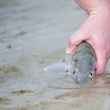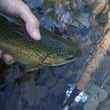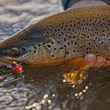The ranks of the catch and release fisherman, whether fly or otherwise, are growing. Even if you're not a no-kill fisherman, it stands to reason that if the fish you're targeting isn't intended for your dinner plate, it is wise to take care to insure that fish is released safely. Not just released, mind you, but released in a manner that takes all reasonable measures to insure that -- once released -- that fish will survive and live on to be caught another day and hopefully spawn. The fact of the matter is that simply releasing a fish does little to insure it's survival if that fish isn't played and handled correctly.
Following are 10 tips for insuring that your catch makes it back into the water for another angler to pursue. While these guidelines are written from the perspective of the trout and salmon fisherman, virtually all of these guidelines apply to other species as well.






























